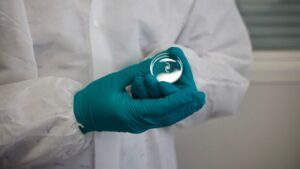3D-printed Lens Implant Could Revolutionize Cataract Surgery

A mixture of photopolymerizable materials developed by researchers in England combined with 3D printing could revolutionize cataract surgery.
A photopolymerizable resin containing 2-phenoxyethyl acrylate, poly (ethylene glycol) dimethacrylate, and a photoinitiator was used to fabricate a prototype device, similar to a non-refractive intraocular lens (IOL), via stereolithography in a proof-of-principle study at the University of East Anglia in Norwich, UK. The process has the potential to accelerate design and manufacture of IOLs and facilitate the production of patient-specific lenses. It also enables expanded research into alternative materials for this application.
Molding and lathing are current IOL fabrication methods.
Cataracts are the leading cause of blindness and the second cause of severe vision impairment worldwide, write the researchers in a paper published online on May 19 in Current Eye Research. The primary methods used to manufacture implantable IOLs currently are molding and lathing. The latter technique involves the production of rods cut into disc-shaped structures that are then machined with a lathe. In both cases, the IOLs are polished to remove artifacts that may affect smoothness while preserving the implant’s sharp edges. While these techniques produce high-quality IOLs, they have several disadvantages, write the researchers led by Associate Professor in Healthcare Technologies Aram Saeed, PhD, andProfessor Michael Wormstone, PhD, at the School of Biological Sciences.

Associate Professor in Healthcare Technologies Aram Saeed, PhD. Image courtesy of Aram Saeed/University of East Anglia.
Current methods are time consuming, requiring demanding cleaning procedures and multiple production steps, write the researchers. They also are labor intensive and require costly specialized equipment. 3D printing eliminates many of these challenges.
SLA accelerates production of IOL prototypes.
Stereolithography (SLA) was the chosen 3D-printing method, because of the “high resolution and speed of fabrication, the versatility of the materials that can be used, and the possibility of using them simultaneously. These attributes make SLA a promising technique to accelerate the production of novel IOL prototypes,” notes the paper.
The photopolymerizable formulation developed in-house for SLA printing enabled the production of IOL prototypes with the requisite mechanical properties. A battery of tests verified the transparency and biocompatibility of the devices. Implantability was evaluated using an internationally recognized suspended human capsular bag system, which was first developed at the University of East Anglia. The SLA-fabricated implant was folded — as is customary when implanting IOLs using current technology — loaded into an injection system, and “implanted” in the capsular bag, which had previously been inflated. Following ejection, the folded implant unfurled and recovered its natural shape without affecting the structural characteristics, according to the paper.
Technology refinements to come.
Further research is needed to apply the process to the manufacture of refractive IOLs, the researchers acknowledged. It remains suitable, however, for prototyping and developing innovative implants to address specific clinical challenges, they note in the paper. Moreover, the proof-of-concept paper is the first in a series that will detail further developments. “As we continue to publish our findings and share our advancements, we aim to be at the forefront of the industry, working with industrial partners and researchers worldwide to refine and enhance the technology,” Saeed told British publication The Engineer.
Article Source: MDDI









